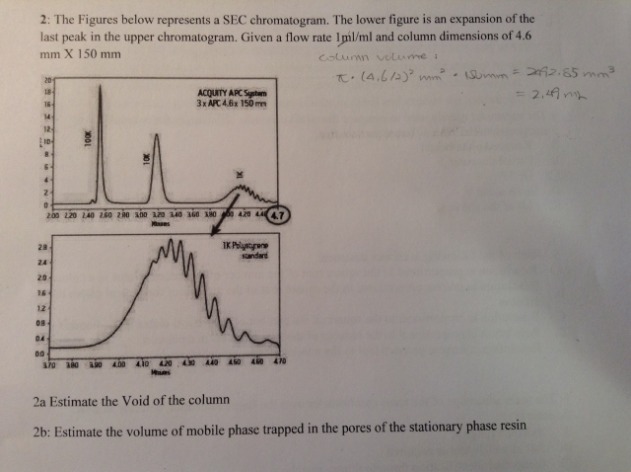-
- Posts: 8
- Joined: Sat Aug 16, 2014 9:22 pm

Advertisement
Basic questions from students; resources for projects and reports.


Since this is a quiz, presumably you have studied the procedure. A few hints:
Hint #1: the calculation you have penciled in is for an empty column. Your column is not empty.
Hint #2: If a molecule is too large to enter the pores, at what time (or volume) will it elute from an SEC column?
Hint #3: If a molecule is small enough to enter all the pores, at what time (or volume) will it elute from an SEC column?
Big molecules come out first since they are exposed to a smaller amount of mobile phase (since they cannot pass through the pores of the resin), small molecules are the last ones to be eluted for the column because they are dealing with a large amount of mobile phase since they pass through the pores. I calculated the void volume of the column to be 2.40min * 1mL/min = 2.40mL since the first peak only start to show up at 2.40min, (or do I use 2.55min which is the centre of the first peak??) not sure this is correct though...:sFlow rate should be mL/min.
You're on the right track, just take your logic further (or look at your notes!). The void volume of the column is the total volume of liquid it contains (i.e., the volume of liquid inside the pores plus the volume of liquid in between the particles, soooo:
Hint #4: *Why* do big molecules come out first? (and why do small molecules come out last?)
Alright!You got it! The time to use is the retention time (highest point) of the last peak.
Re your earlier estimate, that was for an *empty* column. The terminology is a bit confusing, but "column volume" in LC is defined as "the volume of mobile phase in the column" (i.e., the volume between the particles plus the volume in the pores).
Actually, I'd use the little "blip" at about 2.45 minutes as representing the first thing to elute from the column, but that's splitting hairs.is it also the highest point of the first peak (~2.55min)
Separation Science offers free learning from the experts covering methods, applications, webinars, eSeminars, videos, tutorials for users of liquid chromatography, gas chromatography, mass spectrometry, sample preparation and related analytical techniques.
Subscribe to our eNewsletter with daily, weekly or monthly updates: Food & Beverage, Environmental, (Bio)Pharmaceutical, Bioclinical, Liquid Chromatography, Gas Chromatography and Mass Spectrometry.